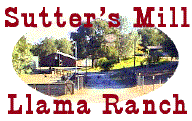 |
Llama Owner Information |
|
|
Habits and Behavior Sutter's Mill Llama Ranch Bill & Sandy Chickering (530) 642-2377 |
Habits & Behavior Lamas have a dignified, aristocratic manner about them. Because of their curiosity, they have a delightful habit of coming close to sniff strangers. But despite your natural temptation to hug and cuddle them, they prefer not to be petted except on their necks and woolly backs. You need have no fear of children around them, as they are gentle and don’t spook easily, and rarely bite or kick unless provoked. They are social animals and need the companionship of another llama or other grazing livestock. Llamas communicate their moods with a series of tail, body and ear postures, and vocalizations. Learning this llama language is one of the joys of ownership. Humming is a common manner of communication between llamas, and indicates a variety of moods from contentedness to aggression. Another interesting llama expression is the shrill, rhythmic alarm call emitted at the sight of a strange animal (especially dogs) or a frightening situation. Spitting, usually related to food disputes, is seldom directed at people unless a llama has been mishandled or become imprinted on people through bottle feeding as a baby. As with bottle-fed stallions, bulls and rams, bottle-fed male llamas that have not been gelded at an early age can be dangerous as adults, because they lack a normal fear of people and regard them as competitors. Llamas are remarkably clean, and even large herds are quite odorless. Dung-piling behavior is an important means of spatial orientation and territorial marking for these historically open habitat animals, and a convenience when you clean their pens. By taking advantage of this habit you can encourage your animals to establish dung piles in a new pen by "pre baiting" four or five sites per acre with a shovel full of llama pellets. You may frequently see your llama rolling in the dirt, taking a dust bath to maintain a healthy, fluffy coat of wool. |